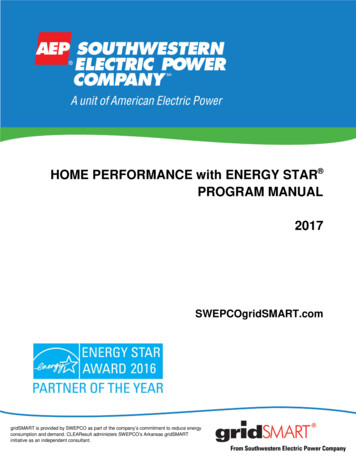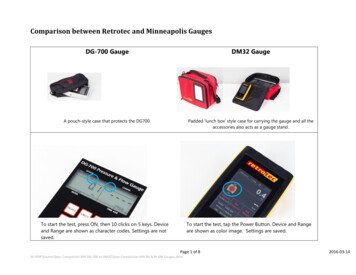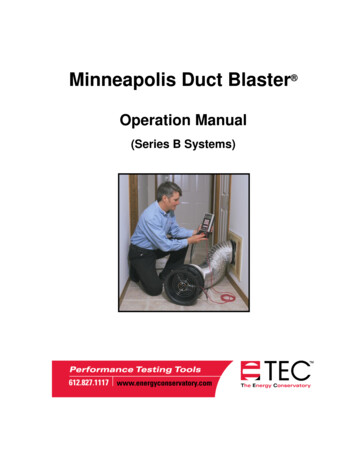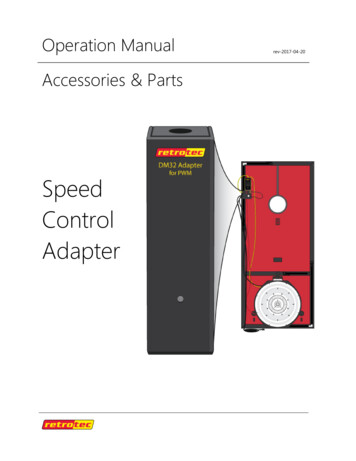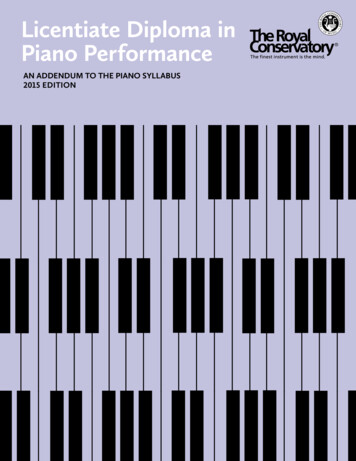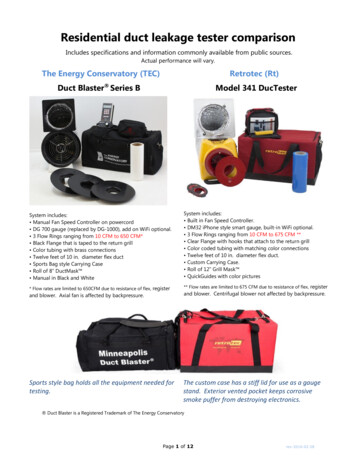
Transcription
Residential duct leakage tester comparisonIncludes specifications and information commonly available from public sources.Actual performance will vary.The Energy Conservatory (TEC)Retrotec (Rt)Duct Blaster Series BModel 341 DucTesterSystem includes: Manual Fan Speed Controller on powercord DG 700 gauge (replaced by DG-1000), add on WiFi optional. 3 Flow Rings ranging from 10 CFM to 650 CFM* Black Flange that is taped to the return grill Color tubing with brass connections Twelve feet of 10 in. diameter flex duct Sports Bag style Carrying Case Roll of 8” DuctMask Manual in Black and WhiteSystem includes: Built in Fan Speed Controller. DM32 iPhone style smart gauge, built-in WiFi optional. 3 Flow Rings ranging from 10 CFM to 675 CFM ** Clear Flange with hooks that attach to the return grill Color coded tubing with matching color connections Twelve feet of 10 in. diameter flex duct. Custom Carrying Case. Roll of 12” Grill Mask QuickGuides with color pictures* Flow rates are limited to 650CFM due to resistance of flex, register** Flow rates are limited to 675 CFM due to resistance of flex, registerand blower. Axial fan is affected by backpressure.and blower. Centrifugal blower not affected by backpressure.Sports style bag holds all the equipment needed fortesting.The custom case has a stiff lid for use as a gaugestand. Exterior vented pocket keeps corrosivesmoke puffer from destroying electronics. Duct Blaster is a Registered Trademark of The Energy ConservatoryPage 1 of 12rev-2016-02-28
Duct tester performance and applicationDuct leakage testing for new construction is typically between 40 to 180 CFM depending on floor areaand Code requirements. Old houses can be above 500 CFM. Both systems will measure duct leakagein any old or new house.Test Equipment and Calibration complies with ASTM E 1554 - 03 ASHRAE 152 RESNET All State Codes Internationally recognized ILAC ISO-17025*accredited calibration lab. ASTM E 1554 - 03 ASHRAE 152 RESNET All State CodesTEC Pros Retrotec ProsSlightly smaller and lighterWhen mounted to air handler cabinet, it cancreate over 1000 CFM of flow.Gauge can be upgraded to tablet style for 450.Calibration cost 100 every two years.Many people have been trained on how to usethem.Military style connectors. TEC Cons FREE online training course included.Most just use the illustrated Quick Guides.Calibrated in an ISO 17025 Accredited Lab.Remembers all your set up for next test whenturned off.Optional flow ranges go down to 0.02 CFMallowing it to be used for a variety of newapplications, such as testing windows.Universal gauge will operate all systems fromRetrotec and TECFollow easy to use color icons on gauge toeliminate set up time and errors.Retrotec ConsFlow ranges can be installed backwards andon the wrong side of the fan.When performing depressurization tests, theflow conditioner and reference tube must beinstalled.Large errors will occur when using Open rangeon a flex because the maximum backpressureof 100 Pa is so easily exceeded.Gauge returns to factory defaults when turnedoff which forces Device, Mode and Range to bereset for each test.Letter codes for Devices, Ranges and resultscan be misinterpreted. Page 2 of 12The End Plate may come loose inside the flexwhile depressurizing but that can be correctedwith the polyurethane tape supplied. Laterversions have a tighter fitting End Plate.Mounting bolts that run through the fan shellcan cause it to crack but there is 10-yearwarranty on the shell. Later models have ametal backing plate that has corrected thisweakness.Gauge calibration is 165 but only has to bedone every 5 years.rev-2016-02-28
Duct Blaster Series BModel 341 DucTesterFour flow ranges are included for flows from 10 to650 CFM* through flex duct and register. OptionalRing 4 measures down to 2.4 CFM.*Note:Four flow ranges are included for flows from 10 to675 CFM. Optional ranges go down to 0.02 CFM* More flow can be achieved where flex duct is not used and fan is tapedonto air handler cabinet.Connect range plates using the U-shaped molding.Snap range plate and/or plugs into place with supermagnets.Page 3 of 12rev-2016-02-28
Flow Sensor is a metal tube that is screwed ontothe motor. It has holes on the downstream sideused to measure flow.Flow Sensor is a venturi nozzle with two annularpressure damping chambers for flow and referencepressure. It is built into the fan housing.Speed control knob (blue arrow) or controlled bygauge. Power and tubing connections shown.Luggage style swiveling handle (blue arrow).Built in speed control knob (blue arrow) withindicator lights or controlled by gauge. Color-codedtube connections. Built in handle (blue arrow).Page 4 of 12rev-2016-02-28
Duct Blaster Series BModel 341 DucTesterDepressurization requires the attachment of theFlow Conditioner with U molding and an additionaltube from Channel B to the flange.Depressurization requires no tubing changes.Optional quick collar makes this connection fast.Set the fan on the foam base to prevent it fromrolling. Fan can be used as an optional poweredflow hood.Padded aluminum base provides stability and isused for handheld powered flow hood operation.DG-700 GaugeDM32 GaugeA pouch-style case protects the DG700. Gaugestand is a plate with Velcro to hold the gauge and aclamp to secure it to a door.Padded ‘lunch box’ style case for carrying the gaugeand all the accessories also acts as a gauge stand.Page 5 of 12rev-2016-02-28
Duct Blaster Series BModel 341 DucTesterTo start the test, press ON, then 10 clicks on 5 keys.Device and Range are shown as character codes.Settings are not saved.To start the test, tap the Power Button. Device andRange are shown as color image. Settings aresaved.Velcro loops mount to a speed control plate thatwill clamp to a door.Rubber non-skid pads, a belt clip and super magnetsare the attachment choices.Page 6 of 12rev-2016-02-28
Duct Blaster Series BModel 341 DucTesterUses six AA batteries.Built-in Lithium-ion battery recharged from a USBcharger in the office or vehicle like a cell phone.Gauge specsAccuracy: 1% of readingCruise Control: 0, 25, 50 and 75 Pa unless WiFi Link isusedDuct testing results: Flow in CFM. Other units availableby connecting to WiFi add-onCompatible duct testing Devices:Accuracy: 1% of readingCruise Control: any pressureDuct testing results: Flow in CFM, CFM/sq ft, CFM/100sq ft & CFM/1000 sq ftCompatible duct testing Devices:Retrotec Model 240, 340, 350 DucTestersTEC Duct Blaster B or Tru-Flow GridTEC Duct Blaster B or Tru-Flow GridFan specsDimensions and weight:10 in. diameter, 7 in. length, 8.5 lbs. with 3 flow rings.System 27 pounds.Dimensions and weight:13 x 11 x 13.25 in., 9 lbs. with 2 flow ringsSystem 26 pounds.MotorCan be operated for up to 2 hours at one time.MotorContinuous duty impeller designed for over 100,000hours of operation.Test direction:Test in both directions. Only when depressurizing, theclear reference hose and flow conditioner must beused.Maximum pressure in flex:100 PaAccuracy claimed:Warranty:Price: 3%2 years 2075Test direction: Works in both directions withoutchanges to set up.Maximum pressure in flex:500 PaAccuracy claimed:Warranty:Price:Page 7 of 12 3% ISO 17025 Accredited2 years, 10 years on shell. 2175rev-2016-02-28
Myths & FactsPerform these tests yourself to learn how to use your equipment accuratelyThe Energy Conservatory (TEC)Retrotec (Rt)Model 341 DucTester Duct Blaster Series BMyth #1 : The Duct Blaster will measure duct leakage over 1,000 CFM.FactWhen the Duct Blaster is on a flex duct which is attached to a return register, it typically cannot achieve therated flow of 1000 CFM on Open Range. Because of the backpressure, it will read much higher than the actual flow.Proof1.2.3.4.5.Install your Duct Blaster on a return using the flex in pressurize mode on Open Range.Seal one supply register closest to the plenum and measure duct pressure there.Run the Duct Blaster at full speed, then seal off registers until 25 Pa is achieved.Measure the Duct Blaster Flow rate. Do NOT use the @ pressure feature.Now run the the Duct Blaster at full speed on Ring 1 and again measure the Duct Blaster Flow rateusing the @ 25 Pa feature to establish the actual flow required to get 25 Pa.What was learned about the Duct BlasterRing 1 should give the same reading as Open Range. Open Range errors start to increase when back pressures arewell in excess of the 100 Pa stated in the Manual. At extremely high back pressures, Open Range will still read highflow rates even though it should read zero (see Myth #2).What was learned about the Retrotec DucTesterThe Model 341 uses a centrigual blower which is not affected by back pressure and will usually get more flow thanthe Duct Blaster on a flex duct.Page 8 of 12rev-2016-02-28
TEC Duct Blaster when completelysealed at the outlet creates 414 Paand flow reads 706 CFM eventhough it’s actually zero.Retrotec DucTester completelysealed creates 656 Pa and flowreads correctly at 0 CFM.Myth #2 : The Duct Blaster will measure 800 CFM at 500 Pa (two inches of water).FactIn this example, the flow is zero but the Duct Blaster incorrectly displays 706 CFM at 414 Pa pressureeven though the flow must be zero since the outlet is taped off.Proof1. On Open range, tape the back of your Duct Blaster to the floor with a static pressure probe underneath.2. Tape it to the floor3. At full speed and read the flow rate.What was learned about the TEC Duct BlasterThe flow rate should read zero because the outlet is completely blocked. The axial fan blade is causing flow to passthe sensor in a circular fashion which gives a flow reading where no net flow through the Duct Blaster actually exists.The 414 Pa back pressure exceeds the maximum 100 Pa the Duct Blaster is rated for so you need to keep this in mind.What was learned about the Retrotec DucTesterThe Model 341 DucTester is not affected by back pressure. In a similar situation you will read a pressure of about 650Pa but the flow will correctly register 0. The Model 341 uses a centrigual blower and sophisticated fault analysis toprevent erroneous readings.Page 9 of 12rev-2016-02-28
Myth #3 : I know my Duct Blaster is accurate because I checked it out on the Field Calibration Plate.FactThe Duct Blaster Field Calibration Plate is only designed to work while depressurizing but chances are you’vebeen trained to test in the pressurization direction so you have not tested your system in the way you’re using it.Proof1.2.3.4.Install your Field Calibration Plate or cardboard with a 4x5” hole on the end of your flex.Measure the CFM on Ring 2 and 3 while depressurizing the flex with the Flow Conditioner.Now perform the same test on Ring 2 and 3 while pressurizing the flex without the Flow Conditioner.Perform additional tests on ducts by using Ring 2 and 3 or Ring 1 and 2 in both directions and compare theresults.What we learned about the Duct BlasterYou should read 107.5 CFM at 25 Pa on the 4x5” hole, 106 CFM in the TEC field Cal plate, 99 CFM on the RetrotecDU159 plate and 98 CFM on the new Red Cal Plate that fits the new Retrotec Clear Flange. You should finddepressurization readings are fairly close to these values.In pressurization, you will typically see Ring 3 reading 20% low, with 5 to 10% errors on Ring 2 being commonplace.This does not necessarily mean these Ranges are in error but it is sure hard to verify that they’re ok. For this reason,we recommend only testing in the depressurization direction which has the added advantage that the register sealswon’t get blown off. In WA and CA you require a pressurization result, so pass the test in depressurization first, then ifall is ok, flip the duct tester around to get a pressurization result.What was learned about the Retrotec DucTesterThe Model 341 DucTester’s Field Calibration Plate works in both directions. You can verify your DucTester is readingcorrectly no matter what direction you test in.Page 10 of 12rev-2016-02-28
Field Tests of TEC Duct Blaster on all Ranges showing accuracy on 10 second averaging.What was learned about the Duct Blaster 1. Results were irregular on actual duct systems when 10 second averaging wasused but were close to 5% for 60 second averaging.2. High backpressures caused by the flex duct while on Open Range created suchlarge errors as to make in unusable.3. Ring 1 is much more accurate and has about the same flow rate eliminating theneed to use Open Range.4. Perform only depressurization tests because they’re faster and can be confirmedwith the Field Calibration Plate.Field Tests of Retrotec DucTester on Open and 74 showing accuracy on 10 second averaging.What was learned about the Retrotec DucTester1.2.3.4.Accuracy of 3% easily obtained for 10 to 20 second averaging.Perform depressurization tests because they’re faster.Confirm accuracy by using a Field Calibration Plate in any test direction.Range 47, 29 and 18 are for very low flows and appear to be very accurate.Page 11 of 12rev-2016-02-28
How does the TEC axial fan compare to the Retrotec centrifugal blower?140 CFM at 500 Pa630 CFM at 250PaTEC Fan Curve shows 650 CFM at 250 PaThe TEC axial fan performs well against small back pressures and is well suited to tests that do notrequire a flexduct. At 250 Pa the TEC fan flow drops to 630 CFM and at 500 Pa has dropped to 140 CFM.575 CFM at 500 Pa750CFM at 250 PaRetrotec Fan is Curve “3” which shows 760 CFM at 250 PaRetrotec blower creates 750 CFM at 250 Pa and still delivers 575 CFM at 500 Pa making it well suited totesting ducts.Page 12 of 12rev-2016-02-28
Myth #1 : The Duct Blaster will measure duct leakage over 1,000 CFM. Fact When the Duct Blaster is on a flex duct which is attached to a return register, it typically cannot achieve the rated flow of 1000 CFM on Open Range. Because of the backpressure
